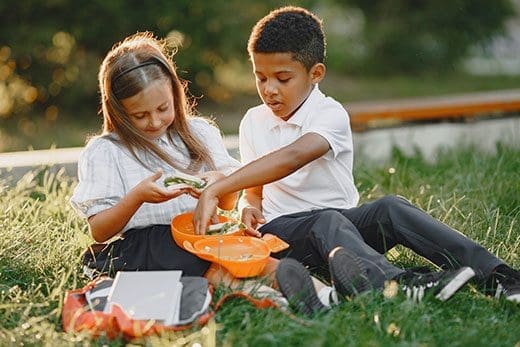Manhattan, Kan. — Modern technology has brought home-packed school lunches along for the ride.
Today’s lunch bags “are made with a high tech material that kids can use to keep their food cold,” said Kansas State University food scientist Karen Blakeslee.
“Back in the old days, a lunch box truly was a metal box,” she said. “Now, these insulated bags can keep your food cold so that kids can have a safe lunch when they’re ready to eat it.”
The insulated versions will keep food cool for about four hours depending on the bag, Blakeslee said, though packing the bag with ice packs or frozen foods is important in determining how cold the food will be.
“It’s best to have at least two frozen packs in the bag,” Blakeslee said. “Ice packs come in many different sizes so they easily fit the lunch bag you use. Or you can freeze juice boxes beforehand, place them in the bag, and they’ll be mostly thawed out when you’re ready to use them.”
Blakeslee urges parents to place the frozen pack or juice box directly next to the item that needs to be kept cold – such as a meat sandwich with cheese. Chips and most whole fruit don’t require refrigeration; some vegetables may need to be kept cool. Blakeslee suggests asking the school if they have a refrigerator for lunch bags to help keep food cold.
“On the other hand, if you have some kind of hot food, it needs to be kept hot,” Blakeslee said. “Purchase an insulated container designed for hot food; there are many options in the market. Like the ice packs, they don’t last all day long, but many can keep food hot about four hours.”
Blakeslee urges parents to plan their children’s menu when shopping each week, and prepare as much of the lunch the night before. Get kids involved with choosing foods, which she says will make them “more likely to eat it.” Rinse fresh fruit and vegetables with water, and prepare any fruits and vegetables so they are ready to eat, she said.
Some healthy choices for lunch include a meat and cheese sandwich with whole grain bread; fresh fruit and vegetables; and a carton of milk they can purchase at school.
To encourage food safety, put a note in their lunch bag to remind children to wash their hands before eating – 20 seconds with warm, soapy water — and pack disposable wipes in the lunch bag as an extra food safety step.
“In the food world, washing your hands does help to prevent a lot of safety issues,” Blakeslee said. “I often see foodborne illness outbreaks that come over the newswire indicating poor personal hygiene as the source of the outbreak. Essentially what that means is that somebody didn’t wash their hands.”
Blakeslee, who is also coordinator of K-State’s Rapid Response Center for food safety, publishes a monthly newsletter called You Asked It! that provides numerous tips on being safe and healthy. More information is also available from local extension offices in Kansas.













